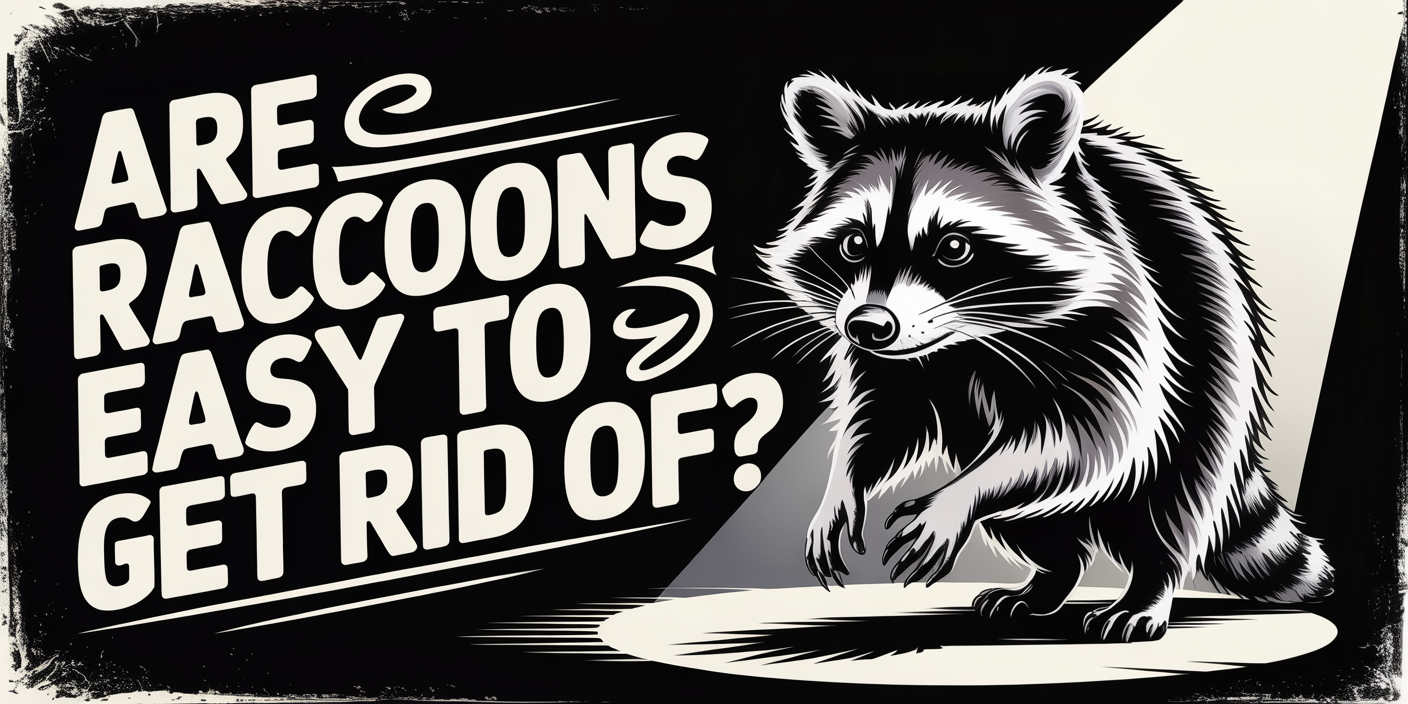“No, raccoons are not easy to get rid of. They’re intelligent, highly adaptable, and often return unless every entry point is sealed and attractant removed. DIY methods rarely work long-term, which is why professional removal is the safest, most effective solution.”
Raccoons might be clever and resourceful, but when you’ve got a raccoon in the attic or crawlspace, it’s more of a nightmare than a nature show. In Florida’s Treasure Coast, the warm climate, accessible water sources, and abundance of food scraps make your property the perfect target. Whether you’re hearing strange noises in the attic or spotting overturned trash cans in the morning, chances are you’re dealing with more than just a curious visitor. Raccoons are persistent, territorial, and often return to the same nesting site unless it’s properly sealed and cleaned.
So, are raccoons easy to get rid of? Not exactly. These critters are surprisingly smart, often travel in family groups, and know how to avoid your average trap or deterrent. Plus, Florida wildlife laws don’t make it easy for homeowners to handle the problem on their own. That’s where a licensed team like AAAC Wildlife Removal of Treasure Coast comes in. With deep experience in humane removal, legal compliance, and long-term exclusion work, we turn a stressful situation into a handled one; quickly, safely, and for good.
Learn more: Does homeowners insurance cover raccoon removal?
Why Do Raccoons Keep Coming Back?
1. Your Property Has Built-In Raccoon Perks
Treasure Coast homes often provide everything a raccoon could ask for: food, water, and shelter. Bird feeders, open trash cans, pet food on the porch, and even compost bins act like a buffet. If a mother raccoon finds a safe, quiet spot to raise her young, like your attic or shed, she’ll mark it as ideal nesting ground. Once she’s had a litter of baby raccoons there, she’s likely to return year after year.
2. The Florida Climate Is Raccoon-Friendly
Warm temperatures and mild winters allow raccoons to stay active all year long. Unlike colder regions where they hibernate or slow down, raccoons in Treasure Coast keep nesting, foraging, and sneaking into attics season after season. With consistent weather and easy food access, it’s no wonder raccoons in your attic become a recurring issue.
3. Entry Points Are Easy to Miss
These animals are incredibly crafty. A raccoon only needs a small gap in the roofline, soffit, or vent to squeeze inside. Without professional removal services and exclusion work, it’s tough to stop raccoons from entering again. Unless every possible access point is sealed, and scent trails are erased, they’ll keep treating your house like home.
What Makes Raccoons Hard to Remove?
Raccoons aren’t just scavengers, they’re incredibly intelligent and cautious. Once they’ve found a safe hiding spot like an attic or crawlspace, they quickly settle in, often creating a den to raise their young. If you remove one raccoon without realizing there are babies nearby, you could be left with crying kits and a bigger mess.
They’re also nocturnal and stealthy, making it difficult for the average homeowner to locate exactly where they’re hiding or how they got in. On top of that, raccoons can be aggressive when cornered and may carry diseases like rabies or leptospirosis.
Even if you manage to trap one, Florida law restricts what you can legally do next, you can’t just release them anywhere. That’s why professional raccoon removal isn’t just more effective, it’s safer and fully compliant with local regulations. Companies like AAAC Wildlife Removal understand the behavior of these animals and have the tools, training, and licensing to deal with the situation the right way.
What Methods Actually Work to Get Rid of Raccoons?
1. DIY Tricks Rarely Get the Job Done
Homeowners often try household deterrents like ammonia, loud music, or flashing lights. While these might startle a raccoon temporarily, they’re rarely enough to force a full retreat, especially if the animal has babies or feels safe in its den. These tricks also don’t address long-term issues like open food sources, entry points, or leftover smells from other animals like a skunk or opossum.
2. Trapping Comes with Legal Limits
Live traps may seem like a practical way to remove a raccoon, but Florida law limits what you can do once the animal is caught. Trapped raccoons must be released on the same property or humanely euthanized. Without professional help, homeowners risk injury, fines, or simply making the problem worse.
3. Professional Exclusion Is the Most Effective Route
The best long-term solution is exclusion. AAAC Wildlife Removal specializes in humane removal combined with expert exclusion work, sealing up entry points, installing one-way doors, and sanitizing nesting areas. This method keeps other wildlife like raccoons, skunks, and opossums from sneaking in later. It’s the safest and most effective way to truly keep raccoons out for good.
4. Targeting Food Sources Around the Property
Raccoons are opportunistic feeders, and Treasure Coast properties often provide plenty of snacks. Eliminating outdoor pet food, securing garbage bins, and removing bird seed or fallen grubs in the yard can reduce interest from raccoons and their wild neighbors. Cutting off these food sources is a major step in keeping raccoons away without relying on scare tactics.
5. Calling in Licensed Animal Control Experts
In many cases, your best move is to contact a licensed animal control provider like AAAC Wildlife Removal. We know how to handle wildlife legally, humanely, and efficiently. Our technicians don’t just remove the raccoons, we figure out why they showed up in the first place and help you keep them from returning.
Can I Get Rid of a Raccoon Myself?
The short answer: you can try, but it’s rarely a good idea. Raccoons are wild animals with strong survival instincts, sharp claws, and the potential to carry dangerous diseases. Raccoons can damage insulation, wiring, and ductwork in the process of building their nests, leading to costly repairs.
Approaching them without proper equipment or training can result in bites, scratches, or even legal trouble. In Florida, raccoon removal is regulated, and the rules are clear: once captured, a raccoon must be released on the same property or euthanized humanely. That’s a serious responsibility for anyone without experience in wildlife handling.
Beyond the health and safety risks, DIY attempts often result in incomplete success. Many homeowners fail to locate baby raccoons, overlook hidden entry points, or miss signs of secondary infestations. That’s why it’s smart to call your local wildlife professionals for help.
At AAAC Wildlife Removal of Treasure Coast, our team offers expert raccoon removal services that are fast, humane, and fully compliant with state laws. We don’t just remove raccoons, we make sure they stay gone.
How AAAC Wildlife Removal Makes It Easy?
Raccoon problems are frustrating, but solving them doesn’t have to be. At AAAC Wildlife Removal of Treasure Coast, we combine deep local expertise with proven wildlife control strategies tailored to Florida’s unique environment.
From the moment we inspect your home, we’re looking at more than just the animal, we’re identifying how and why it got in, what damage was done, and what needs to happen to keep it from coming back. Our process includes humane trapping, full exclusion work, cleanup and sanitation, and even help with documentation if you’re dealing with insurance.
We know the laws, we know the behavior patterns, and we know how to get results fast. Whether you live in Port St. Lucie, Fort Pierce, Vero Beach, or anywhere in between, our licensed team is ready to help you reclaim your home from raccoon invaders, for good.
How Long Does It Take to Get Rid of Raccoons?
The timeline for raccoon removal can vary depending on the size of the infestation, how long the animals have been nesting, and how many entry points exist. In some cases, a single adult raccoon can be removed in just a day or two.
But if there’s a family with babies, or if the raccoon has damaged multiple areas of the home, it may take several days to fully trap, remove, and seal everything up. The longer they’ve been there, the more thorough the process needs to be.
At AAAC Wildlife Removal of Treasure Coast, our goal is fast, effective results without cutting corners. We start with a detailed inspection, use humane removal methods, and follow through with exclusion and sanitation. Most homes see full resolution within a few days, but the quality of work we do ensures those raccoons don’t come back next season. It’s not just about quick fixes, it’s about long-term peace of mind.
So, Are Raccoons Easy to Get Rid Of?
Truthfully, getting rid of raccoons isn’t easy, especially here in Treasure Coast, where the environment works in their favor. These animals are smart, sneaky, and incredibly persistent. Even if you manage to scare one off, it’ll likely return unless every attractant is removed and every access point is sealed.
And without following Florida’s strict wildlife laws, DIY removal can cause more trouble than it solves. That’s why partnering with a licensed professional like AAAC Wildlife Removal is the smartest move.
We understand the local raccoon behavior, know how to find hidden dens, and handle the entire process legally and humanely. From removal and exclusion to cleanup and prevention, we make it easy to take back your space, for good. If raccoons have moved in, don’t wait for them to settle. Let us help you fix it the right way, right away.




